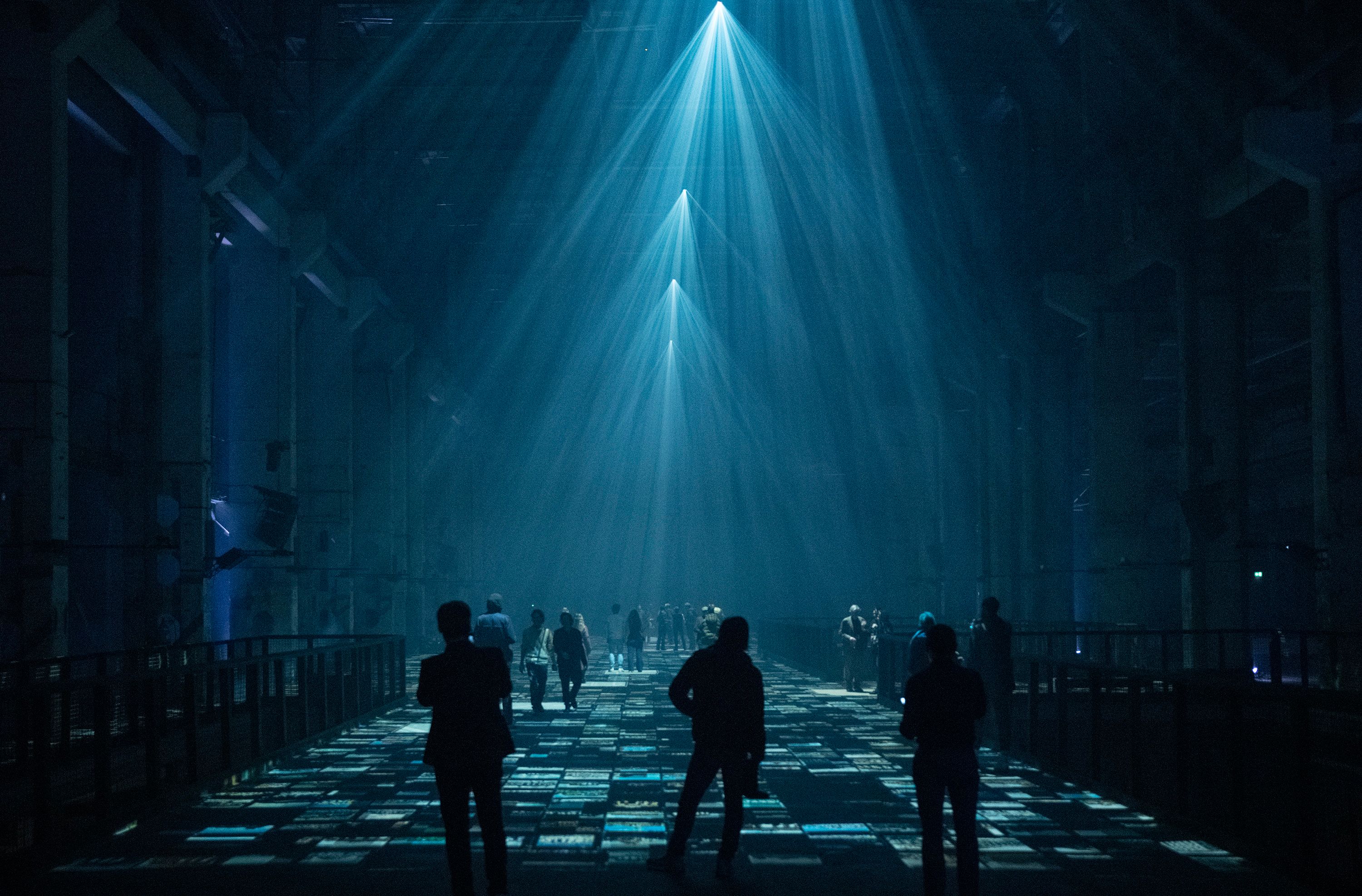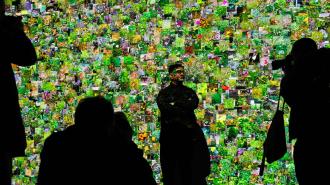On November 19, 2022, crowds of people flooded the Museum of Modern Art (MoMA) to attend the opening of Refik Anadol’s “Unsupervised.” Enormous high-fidelity LED screens covered the walls, showing billions of brightly colored pixels coalescing into infinitely complex patterns reminiscent of clouds, crashing waves, and spiderwebs. The visually striking spectacle continued to wow visitors for almost a year, the exhibit extended in response to popular demand. But the real magic — or mathematics — of “Unsupervised” lies beneath its mesmerizing surface.
The Turkish-born, Los Angeles-based Anadol is one of the world’s leading artists working with artificial intelligence. For “Unsupervised,” he had a self-improving algorithm process the MoMA’s labyrinthine catalogue of modern and postmodern art, before ordering it to create something of its own. The end result, as Travis Deahl summed it up in a review for The New York Times, is art history in motion: input past trends, output “the next avant-garde.”
“Information can become a pigment, and … this pigment can take any shape or form.”
Refik Anadol
Just as each new generation of artists turns to the past for inspiration, either inheriting a tradition or consciously rejecting it to try something new, the algorithm of “Unsupervised” looks at what came before to envision what could come next. The key difference is that it, unlike a human artist, can look at everything — and do so in the blink of an eye.
Like many massively successful artists — Anadol has won numerous awards and exhibited his work at numerous museums, galleries, events, and public locations, including the National Gallery of Victoria, the Walt Disney Concert Hall, and the Arc De Triomf — he has proven a somewhat divisive figure. Some refer to his output as glorified lava lamps and premium screensavers. Others see it as the logical continuation of a period of experimentation and demystification that began over a century ago, when similarly iconoclastic artists were put on the stake for challenging what could and could not be considered art.
“For artists such as myself, we love to break things.”
Refik Anadol
In the following interview, Refik Anadol, calling from his studio in LA, offers a look inside his mind — and the minds of the machines he works with.
Sculpting with data
Anadol began his career studying video and photography at Bilgi University in Istanbul, after which he moved to the United States to enroll in the Design Media Arts program at UCLA. It was on the West Coast, under the mentorship of Peter Weibel (the post-conceptual artist and ZKM Center for Art and Media Karlsruhe founder), that he stumbled upon what would become the golden thread connecting his vast oeuvre:
“Weibel taught me that information can become a pigment, and that this pigment can take any shape or form. There is no bias there. There is no Newtonian thinking, no limits of life.”
What makes Anadol’s algorithms stand out … is his willingness to encourage hallucination.
A self-described data painter and sculptor, Anadol has dipped his “thinking brushes” into many different types of information over the years. For his 2020 show “Quantum Memories,” completed after being invited to work at Google as their first artist-in-resident, he trained an algorithm on the approximately more than 200 million images of nature and landscape images stored in the search engine’s massive database.
“Living Architecture: Casa Batlló” (2023) saw Anadol projecting images, constructed from real-time climate readings, onto Catalan architect Antoni Gaudí’s Casa Battló building in Barcelona. “Melting Memories” (2018) used AI trained on research data from studies on Alzheimer’s disease and brain functioning, while the coding behind “Winds of Yawanawa” (2023) combined local weather reports with the traditional craftsmanship from an Indigenous village in Brazil threatened by deforestation of the Amazon.

Some critics disliked “Unsupervised” because Anadol’s algorithmically generated artwork bore little to no visible trace of the familiar modern and postmodern art that made up its training data. But that, the artist has retorted, is precisely the point. Part of what makes artificial intelligence intelligent is its ability to think for itself. If you exercise complete control over its processing, it becomes a tool rather than a collaborator. What makes Anadol’s algorithms stand out from the myriad of image generators available on the internet is his willingness to encourage hallucination — to allow the programs to make mistakes and “misinterpret” their input, leading to unexpected and interesting results.
“AI research is heavily focused on trying to make AI as accurate as possible in trying to mimic reality,” he explains. “But for artists such as myself, we love to break things. We love to do things that are not normal. We want to see, not reality, but chance, dreams, mistakes, imperfections, hallucinations, to find a new language and vocabulary.”
Artificial intelligence and art
In 1913, classically trained fine art students from the Art Institute of Chicago were so outraged by the new wave of European abstract art on display at their institution that they staged a mock trial for the exhibit’s most revolutionary participant: Henri Matisse. A student dressed as the French artist — calling himself “Henry Hairmatress” — was put in chains and dragged out into the building’s courtyard, where a fake jury charged him with “artistic murder, pictorial arson, artistic rapine, total degeneracy of color, criminal misuse of line, general esthetic aberration, and contumacious abuse of title.”
Reproductions of some of Matisse’s best-known paintings, including “Le Luxe II,” “Goldfish and Sculpture,” and “Blue Nude,” were burned, while the student representing him was executed (performatively).
“Artists are the alarm mechanisms of humanity. We always see things way before.”
Refik Anadol
Asked if the traditional art world’s virulent opposition to early 20th-century art movements like Cubism and Fauvism mirrored the disapproval that AI artists face from established critics today, Anadol nods his head in agreement.
“It’s 100% the same pattern,” he says. “Been there, done that. The responses we sometimes get are also similar to the ones that Jackson Pollock and Mark Rothko received. In fact, all the heroes of humanity received similar responses. They opened the curtains, and whenever they did, there was this reaction. Artists are the alarm mechanisms of humanity. We always see things way before.”
Given that opposition to modern art eventually diminished, its champions becoming the new status quo, it’s likely the same thing will happen with AI art in the future. In our current age of information, where social transformations occur more quickly than they did in the past, you could argue this is already happening.
“The way machines make art isn’t all that different to the way humans do.”
Refik Anadol
Refik Anadol’s work has more in common with that of Matisse, Pollock, and Rothko than one would think. Like these pioneers, Anadol and his peers are trying to push the boundaries of what can and cannot be considered art. Just as the former challenged the value of realism in art, the latter are now questioning the value of human involvement itself. Although they have at times been accused of the contrary, their work fits squarely in the modern and postmodern tradition, insofar as it exposes the flaws of ideas normally taken for granted — in this case, the limits of creativity and imagination. To study an artwork produced by AI is to demystify the creative process, which can indeed be translated into a line of code. As “Unsupervised” showed audiences, the way machines make art isn’t all that different to the way humans do: both absorb previous experiences — data — and recombine existing parts to create something new.
“Sometimes people don’t see the depth of my work,” Anadol says. “Sometimes they can only see the beautiful aesthetics on the surface. But the meat is beyond that. One of the reasons I think our exhibitions received significant positive responses was that we demystified AI.”
We’d love to hear from you! If you have a comment about this article or if you have a tip for a future Freethink story, please email us at [email protected].






